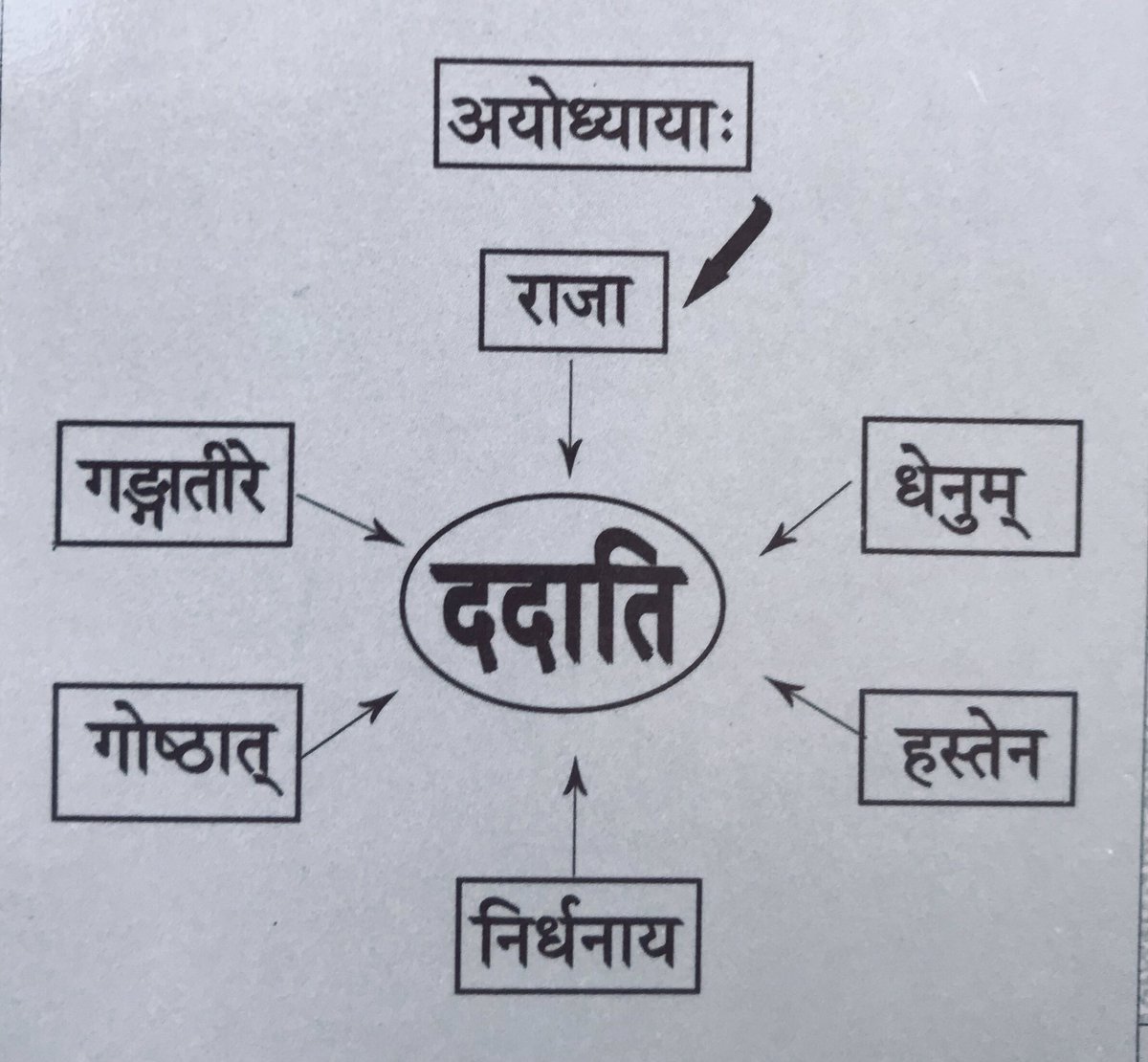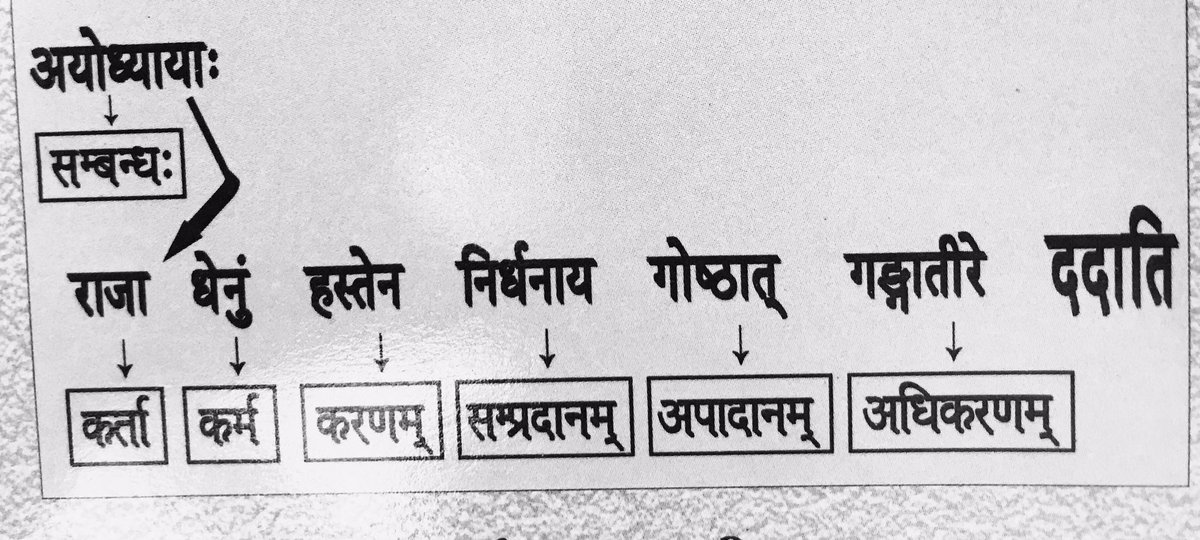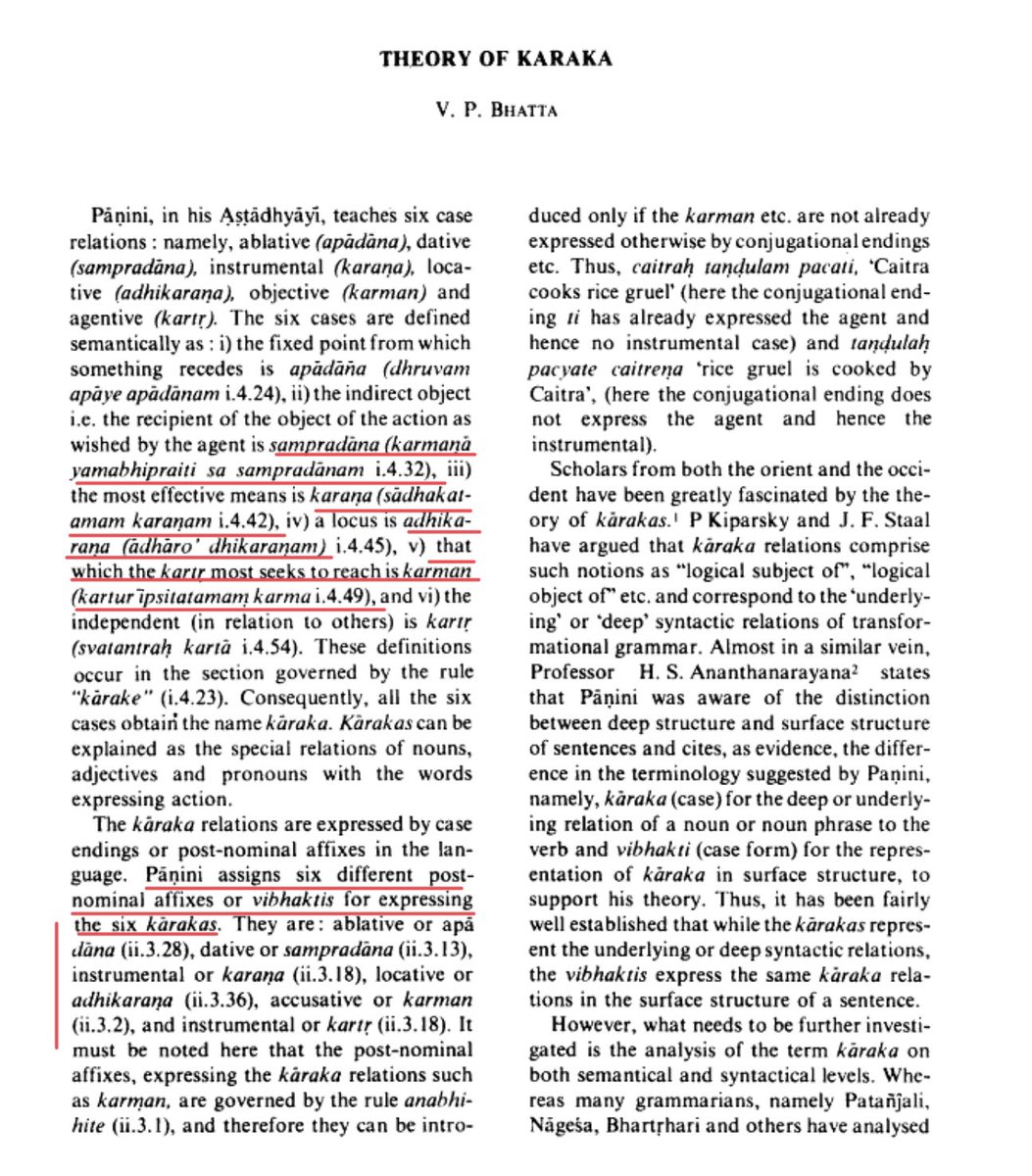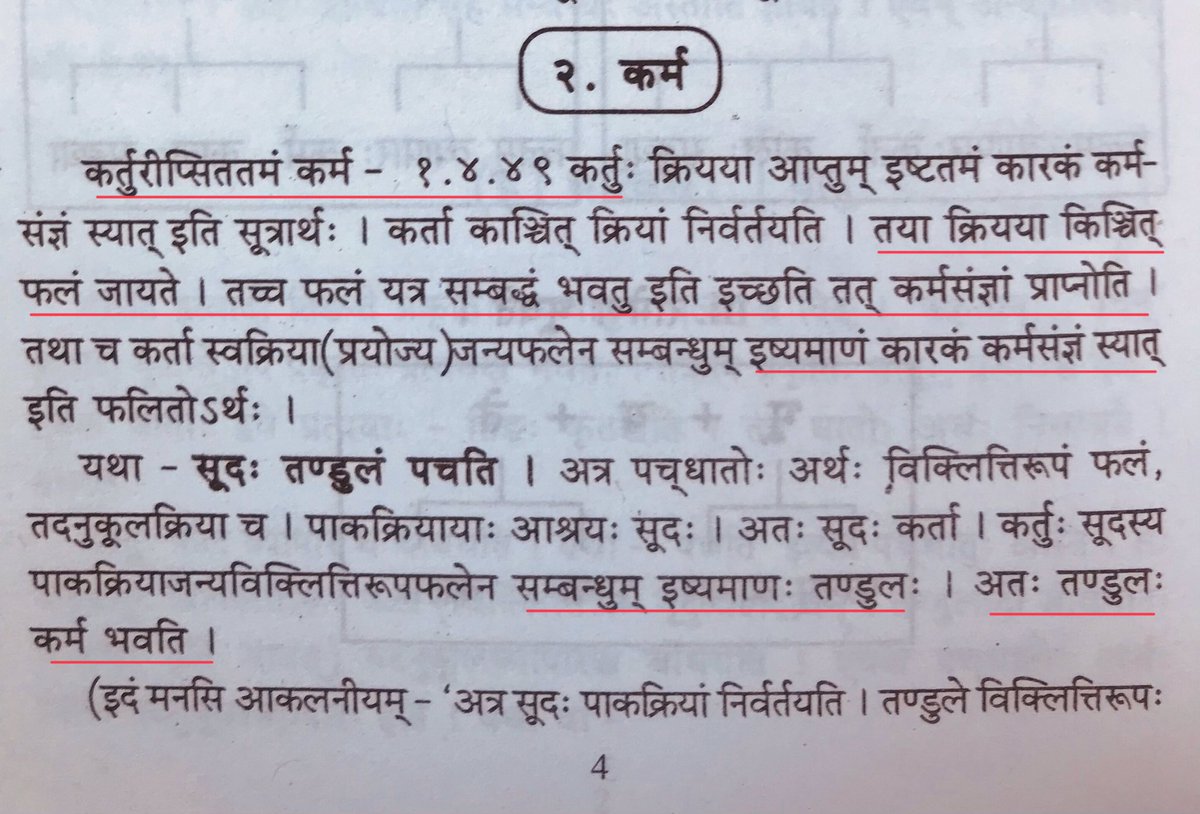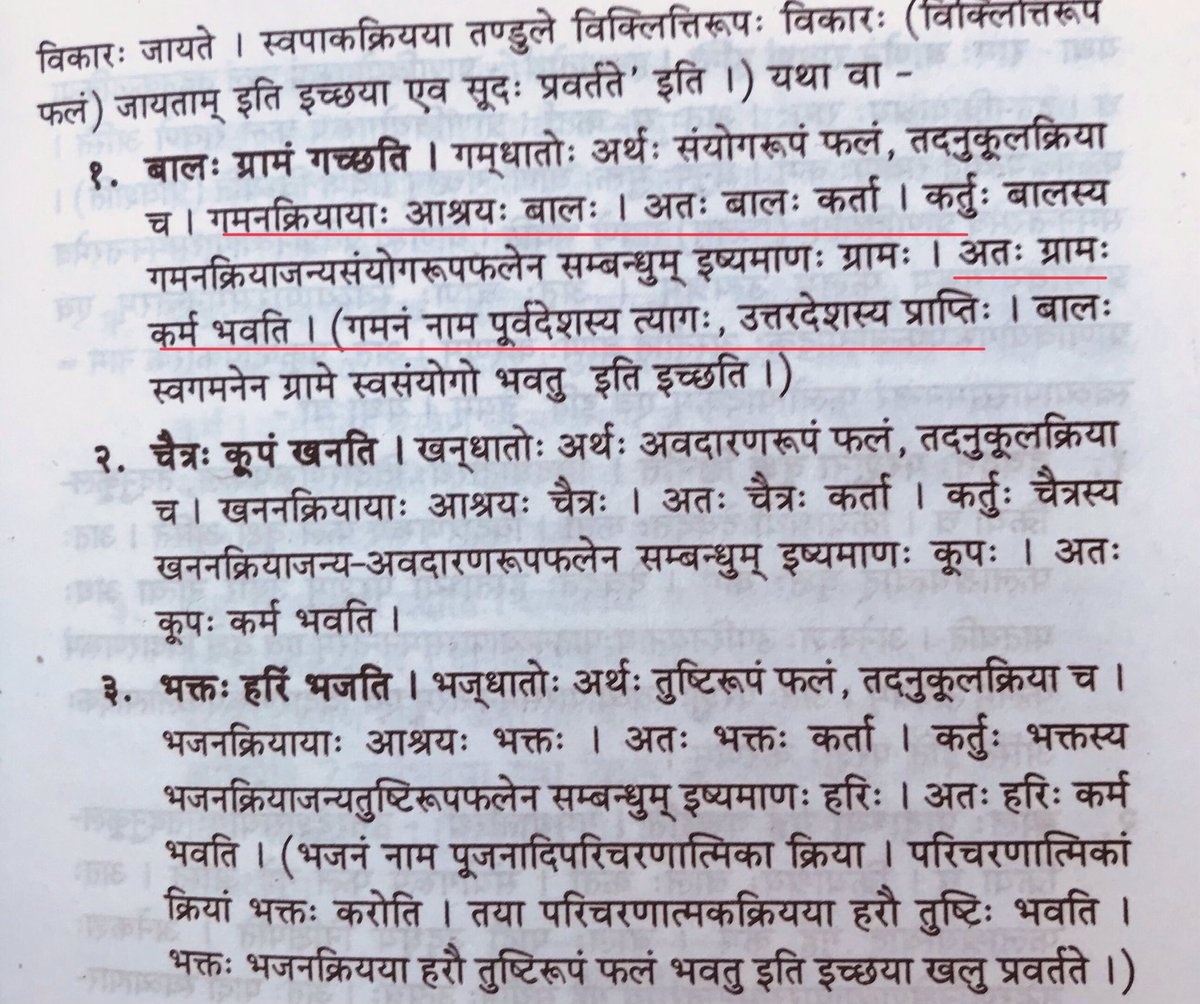To answer this, need to delve into the कारक (KARAKA) theory- a brilliant framework to understand & analyse sentences
क्रियान्वयि कारकम् इत्युक्तम्।
Simply put, कारक are the relationship of different components of a sentence like noun, pronoun & adjectives to the VERB (action) https://twitter.com/vibhavasu_/status/1388361120667226113">https://twitter.com/vibhavasu...
क्रियान्वयि कारकम् इत्युक्तम्।
Simply put, कारक are the relationship of different components of a sentence like noun, pronoun & adjectives to the VERB (action) https://twitter.com/vibhavasu_/status/1388361120667226113">https://twitter.com/vibhavasu...
Take the example
अयोध्यायाः राजा धेनुं हस्तेन निर्धनाय गोष्ठात् गङ्गातीरे ददाति।
The action/doing is the VERB-ददाति
All other components are connected to the VERB via multiple ‘relationships’-signified by Karakas
Doer is कर्ता
Object of action is कर्म
Locus is अधिकरणम्
etc
अयोध्यायाः राजा धेनुं हस्तेन निर्धनाय गोष्ठात् गङ्गातीरे ददाति।
The action/doing is the VERB-ददाति
All other components are connected to the VERB via multiple ‘relationships’-signified by Karakas
Doer is कर्ता
Object of action is कर्म
Locus is अधिकरणम्
etc
There are 6 कारकाः which are signified by various विभक्तिः endings in संस्कृतम्
कर्ता - Nominative
कर्म - Accusative
करणम् - Instrumental
सम्प्रदानम् - Dative
अपादावम् - Ablative
अधिकरणम् - Locative
कर्ता - Nominative
कर्म - Accusative
करणम् - Instrumental
सम्प्रदानम् - Dative
अपादावम् - Ablative
अधिकरणम् - Locative
Now what is कर्ता & कर्म ?
स्वतन्त्रः कर्ता & कर्तुरीप्सिततमं कर्म
The doer / agent is Karta and what the कर्ता seeks MOST to effect (कर्तुरीप्सिततमम्) is कर्म
Similarly साधकतमं करणम् - the most effective ‘means’ is करणम् Karana
Etc.
स्वतन्त्रः कर्ता & कर्तुरीप्सिततमं कर्म
The doer / agent is Karta and what the कर्ता seeks MOST to effect (कर्तुरीप्सिततमम्) is कर्म
Similarly साधकतमं करणम् - the most effective ‘means’ is करणम् Karana
Etc.
Now what is अकथितम् ?
Normally, sentences have a कर्ता (doer), Kriya (the action) & object of action (कर्मन्)
In कर्तरी प्रयोगः (active voice), कर्ता is in प्रथमा Normally, sentences will have a कर्ता (doer), Kriya (the action) and the object of action (कर्मन्)
Normally, sentences have a कर्ता (doer), Kriya (the action) & object of action (कर्मन्)
In कर्तरी प्रयोगः (active voice), कर्ता is in प्रथमा Normally, sentences will have a कर्ता (doer), Kriya (the action) and the object of action (कर्मन्)
So if we take a sentence like पिता पुत्रं सन्देशं पृच्छति
पिता is the कर्ता & पृच्छति is the क्रिया, but which one is the कर्मन्? Is it पुत्रः or सन्देशः ? Both are shown here in द्वितीया विभक्तिः ?
पिता is the कर्ता & पृच्छति is the क्रिया, but which one is the कर्मन्? Is it पुत्रः or सन्देशः ? Both are shown here in द्वितीया विभक्तिः ?
Also if we take these 2 forms
पिता पुत्रं सन्देशं पृच्छति or पिता पुत्रात् सन्देशं पृच्छति
Which one is correct?
The answer is both are correct. But why?
पिता पुत्रं सन्देशं पृच्छति or पिता पुत्रात् सन्देशं पृच्छति
Which one is correct?
The answer is both are correct. But why?
In the sentence पिता पुत्रं सन्देशं पृच्छति, there are actually TWO कर्मपदे - पुत्रः & सन्देशः।
So this is an example of what is called a द्विकर्मक-वाक्यम्।- those with 2 karma padas
Here पुत्रम् is termed ‘गौणकर्मपदम्’ & सन्देशम् is termed the ‘प्रधानकर्मपदम्’
So this is an example of what is called a द्विकर्मक-वाक्यम्।- those with 2 karma padas
Here पुत्रम् is termed ‘गौणकर्मपदम्’ & सन्देशम् is termed the ‘प्रधानकर्मपदम्’
There are 16 dhatus that allows for 2 karma padas
They can be classified into 2 groups
दुह्-याच्-पच्-दण्ड्-रुधि-प्रच्छि-चि-ब्रू-शासु-जि-मथ्-मुषाम् |
नी-हृ-कृष्-वहाम् ||
They can be classified into 2 groups
दुह्-याच्-पच्-दण्ड्-रुधि-प्रच्छि-चि-ब्रू-शासु-जि-मथ्-मुषाम् |
नी-हृ-कृष्-वहाम् ||
In the simple sentence पिता सन्देशं पृच्छति
सन्देशः gets the कर्मसज्ञ via the sutram कर्मणि द्वितीया (२.३.२)
Now in the expanded sentence पिता पुत्रं सन्देशं पृच्छति, पुत्र also gets the कर्मसज्ञ using the sutram अकथितम् च।
सन्देशः gets the कर्मसज्ञ via the sutram कर्मणि द्वितीया (२.३.२)
Now in the expanded sentence पिता पुत्रं सन्देशं पृच्छति, पुत्र also gets the कर्मसज्ञ using the sutram अकथितम् च।
अकथितं च essentially means अपादानादि which are ‘un-mentioned’ gets the karma label [अपादानादिविशेषैरविवक्षितं कारकं कर्मसंज्ञकं स्यात् इति सूत्रार्थः]
What is अपादानादि ?
The 4 karakas अपादानम् सम्प्रदानम् करणम् & अधिकरणम् are together called अपादानादि कारकाणि |
What is अपादानादि ?
The 4 karakas अपादानम् सम्प्रदानम् करणम् & अधिकरणम् are together called अपादानादि कारकाणि |
When अपादानादि occurs as अकथितम् in a sentence, then these terms also get कर्मसज्ञ।
पिता पुत्रं सन्देशं पृच्छति or पिता पुत्रात् सन्देशं पृच्छति BOTH are viable
पृच्छति-क्रिया
पिता-कर्ता
सन्देशः is कर्तुरीप्सिततमम् & hence get the कर्मसज्ञ-> द्वितीया विभक्तिः -> सन्देशम्।
पिता पुत्रं सन्देशं पृच्छति or पिता पुत्रात् सन्देशं पृच्छति BOTH are viable
पृच्छति-क्रिया
पिता-कर्ता
सन्देशः is कर्तुरीप्सिततमम् & hence get the कर्मसज्ञ-> द्वितीया विभक्तिः -> सन्देशम्।
अकथितं च says अपादानादि gets कर्मसज्ञ when they are अनुक्तम्।
पिता {पुत्रात्} सन्देशं पृच्छति is a perfectly grammatical alternative which uses अपादान कारक
If a speaker doesn’t wish to use (अनुक्तम्) अपादानादि, then, अकथितं च gives it कर्मसज्ञ & hence confers द्वितीया विभक्तिः
पिता {पुत्रात्} सन्देशं पृच्छति is a perfectly grammatical alternative which uses अपादान कारक
If a speaker doesn’t wish to use (अनुक्तम्) अपादानादि, then, अकथितं च gives it कर्मसज्ञ & hence confers द्वितीया विभक्तिः
Therefore, if a term in a sentence has सम्प्रदानत्वम् अपादानत्वम् or अधिकरणत्वम् relationship which is अनुक्तम् [un-mentioned] then they get कर्मसज्ञ via this rule
The term (पुत्र) in this sentence iscalled गौणकर्म while the ‘original’ कर्म (सन्देश) is termed मुख्यकर्म
The term (पुत्र) in this sentence iscalled गौणकर्म while the ‘original’ कर्म (सन्देश) is termed मुख्यकर्म
Hence, both sentence options are correct
पिता पुत्रं सन्देशं पृच्छति
OR
पिता पुत्रात् सन्देशं पृच्छति
If you don’t want to use अपादान कारकम् then गौणकर्म will also get कर्मसज्ञ & hence द्वितीया विभक्तिः।
QED
Now, why are there 2 categories of 16 dhatus that are द्विकर्मक?
 https://abs.twimg.com/emoji/v2/... draggable="false" alt="👇" title="Rückhand Zeigefinger nach unten" aria-label="Emoji: Rückhand Zeigefinger nach unten">
https://abs.twimg.com/emoji/v2/... draggable="false" alt="👇" title="Rückhand Zeigefinger nach unten" aria-label="Emoji: Rückhand Zeigefinger nach unten">
पिता पुत्रं सन्देशं पृच्छति
OR
पिता पुत्रात् सन्देशं पृच्छति
If you don’t want to use अपादान कारकम् then गौणकर्म will also get कर्मसज्ञ & hence द्वितीया विभक्तिः।
QED
Now, why are there 2 categories of 16 dhatus that are द्विकर्मक?
To be continued... https://abs.twimg.com/emoji/v2/... draggable="false" alt="😎" title="Lächelndes Gesicht mit Sonnenbrille" aria-label="Emoji: Lächelndes Gesicht mit Sonnenbrille">
https://abs.twimg.com/emoji/v2/... draggable="false" alt="😎" title="Lächelndes Gesicht mit Sonnenbrille" aria-label="Emoji: Lächelndes Gesicht mit Sonnenbrille">

 Read on Twitter
Read on Twitter